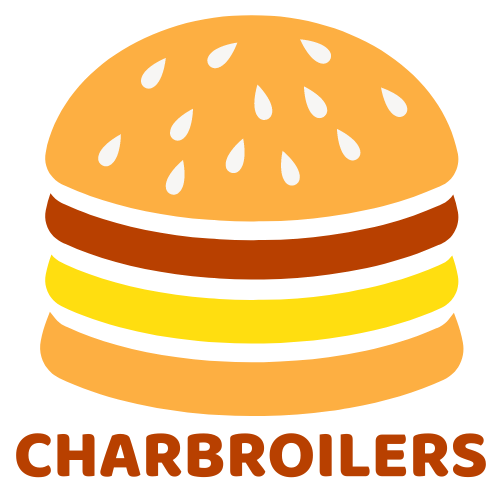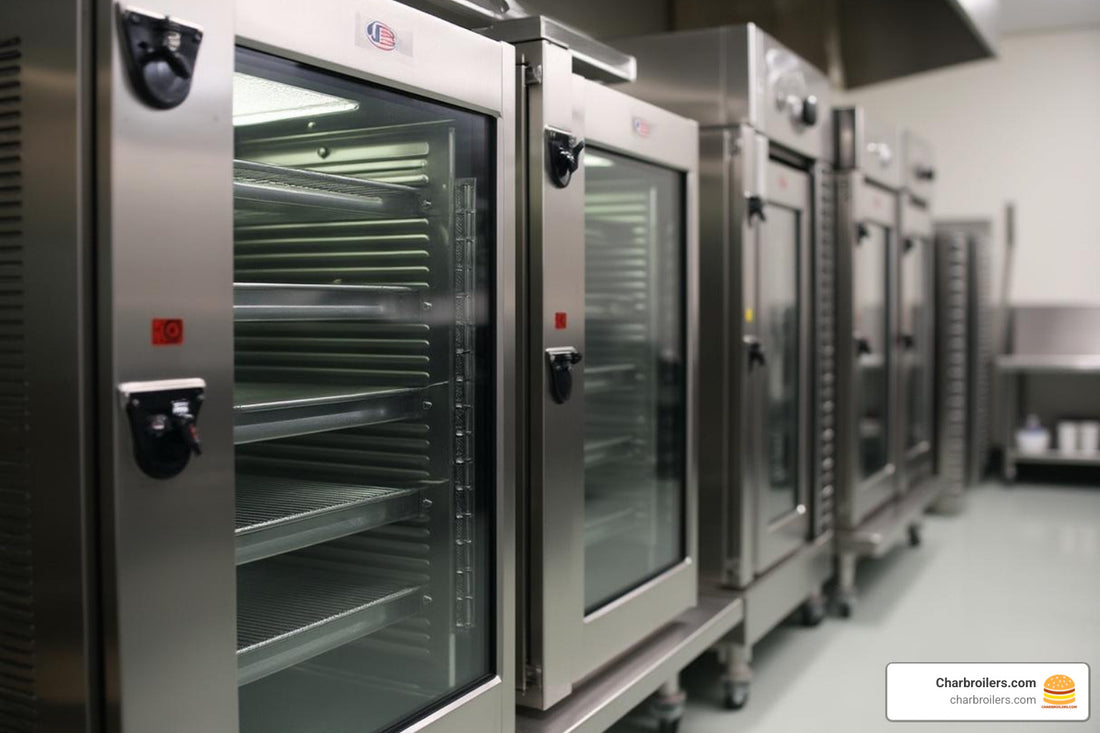
Bake Smarter, Not Harder – A Guide to Used Commercial Convection Ovens
Share
Why Used Commercial Convection Ovens Are Smart Business
Used commercial convection ovens offer restaurant owners a proven path to professional-grade cooking without the premium price tag. These workhorses can cost up to 70% less than new models while delivering the same 25% faster cooking times and consistent results your kitchen demands.
Quick Guide to Used Commercial Convection Ovens:
- Price Range: $175 - $5,000 (vs. $3,000 - $15,000+ new)
- Energy Savings: ENERGY STAR certified models save ~$188 annually on gas bills
- Cooking Speed: 25% faster than conventional ovens
- Capacity Options: Quarter-size, half-size, and full-size models available
- Power Types: Electric (120V-240V) and gas (natural/propane) options
- Typical Lifespan: 10+ years with proper maintenance
The used commercial equipment market is thriving, with over 40 convection ovens typically available across Canada at any time. Smart operators know that a well-maintained used unit can deliver the same crispy exteriors, even browning, and multi-rack efficiency as brand-new equipment.
Beyond the obvious cost savings, choosing used equipment supports sustainability by extending equipment lifecycles. It also means faster delivery times - no waiting months for factory production when you need to get cooking now.
I'm Sean Kearney, founder of Charbroilers.com with over a decade in the restaurant equipment industry, and I've helped countless operators find the perfect used commercial convection ovens for their kitchens. After working at Amazon and founding multiple equipment companies, I've seen how the right used equipment can transform a restaurant's efficiency and profitability.
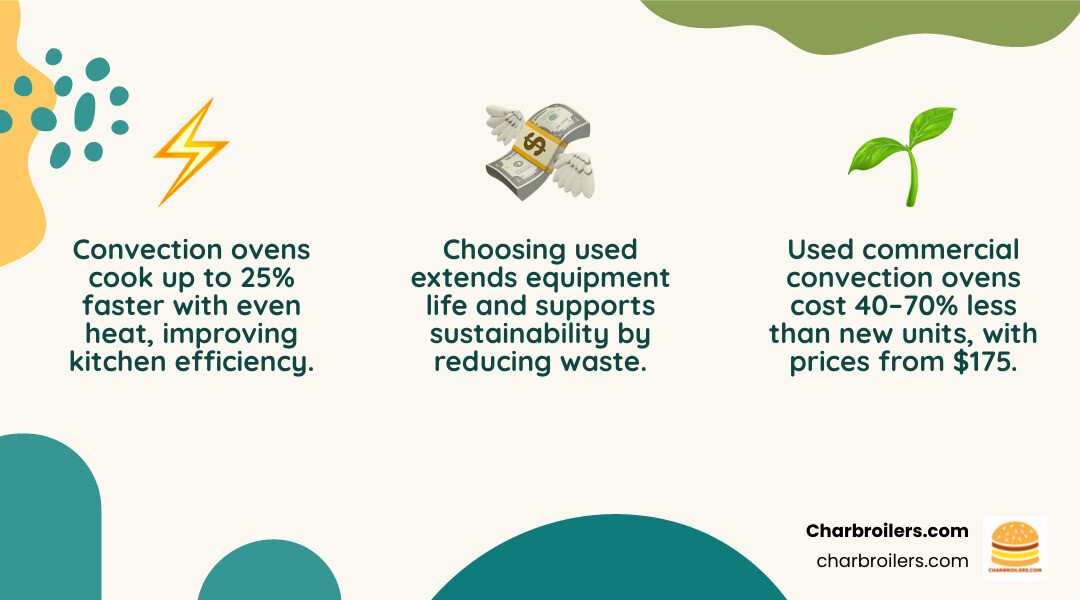
Used commercial convection ovens vocab explained:
Why Choose Used Commercial Convection Ovens?
The restaurant equipment world has a not-so-secret secret: used commercial convection ovens deliver the same professional results as brand-new units, but at a fraction of the cost. It's like finding designer jeans at a thrift store—same quality, way better price.
Here's the reality of commercial oven depreciation: the moment that shiny new convection oven gets delivered to its first kitchen, it loses 40% of its retail value. After a couple years of faithful service, you can snag these workhorses for 60-70% off their original price. That $4,000 oven suddenly becomes a $1,200 steal.
This steep depreciation curve works in your favor when you're the second owner. You're getting a shorter payback period because your initial investment is so much lower. Many operators find they recoup their used oven costs in under a year, compared to the 2-3 years it might take with new equipment.
Don't think "used" means "slower." These ovens still deliver those 25% faster cook times that make convection technology so valuable. The powerful fans that circulate hot air don't lose their magic just because someone else broke them in first.
Energy efficiency remains a huge win with used commercial convection ovens. ENERGY STAR certified gas ovens slash bills with at least 49% cooking energy efficiency, saving around $188 annually on utility costs. That's money back in your pocket every single month.
The marketplace volume works in your favor too. With over 40 used units typically available across Canada at any time, you've got plenty of options for size, brand, and features. No settling for "close enough"—you can find exactly what your kitchen needs.
Choosing used equipment also supports eco-friendly reuse. Every used oven that finds a new home is one less piece of heavy steel heading to a landfill. It's good business and good for the planet.
Key Benefits of Used Commercial Convection Ovens
The performance benefits don't disappear when you buy used. You're still getting 25% quicker cooking times that help you power through dinner rushes without breaking a sweat.
Multi-rack capacity means maximum output from your kitchen space. Full-size units can handle 5-20 standard sheet pans at once, letting you roast vegetables, bake desserts, and finish proteins simultaneously.
That signature uniform browning comes from the circulating air system—and it works just as well in a used oven. Every cookie, every roasted chicken, every tray of vegetables gets the same perfect golden finish.
Lower utility bills are another ongoing benefit. High-efficiency models use less gas or electricity for the same cooking results, month after month.
The scalability factor is huge for growing businesses. Starting with a used half-size model? You can add a second deck or upgrade to full-size as your volume grows, without the massive financial hit of buying everything new.
Hidden Costs New Buyers Avoid with Used Commercial Convection Ovens
New equipment comes with surprise expenses that can blow your budget. Delivery fees often appear as line items you didn't expect, especially for heavy commercial ovens.
That initial depreciation hits immediately—you're paying full retail for equipment that's worth significantly less the moment it's installed. With used equipment, someone else already absorbed that financial hit.
Long lead times can kill your timeline. Custom specifications or global supply chain delays might mean waiting months for a new oven when you need to start cooking next week.
Installation packages for new units sometimes require authorized technicians or specific setup procedures that get bundled into inflated pricing. With used commercial convection ovens, these costs are typically much lower or already factored into the purchase price.
Inspecting & Evaluating a Second-Hand Unit
Not all used ovens are created equal—some are kitchen heroes, others are one burnt tray away from retirement. Here’s how we (and you) separate the wheat from the chaff:
- Visual Checks: Look for dents, rust, and signs of neglect.
- Fan Integrity: The fan is the heart of convection—listen for odd noises or wobbles.
- Door Gasket: A cracked or worn gasket leads to heat loss and uneven bakes.
- Control Panel & Thermostat: Buttons, dials, and digital displays should be responsive and accurate.
- Service Records: Ask for maintenance logs—regular servicing is a good sign.
- Trial Bake: If possible, run a quick test with bread or cookies.
- Safety Certification: Look for NSF, CUL, or other commercial safety marks.
In-Person Walk-Through Checklist for Used Commercial Convection Ovens
Bring this checklist (and a flashlight) for your inspection:
- Exterior Dents or Dings: Cosmetic damage is okay, but beware of structural issues.
- Interior Rust or Grease Buildup: Heavy rust is a red flag; light surface rust can be cleaned.
- Sheet-Pan Fit: Make sure racks slide smoothly and pans fit as intended.
- Thermostat Accuracy: Use an oven thermometer to check for temperature drift or hotspots.
Remote-Purchase Due Diligence
Buying online or from afar? Protect yourself:
- Video Demo: Request a live or recorded demonstration—watch the oven heat up, cycle, and cool down.
- Seller Warranty: Ask about 30-day or 90-day guarantees, even on used units.
- Return Window: Ensure you have at least a week to test and return if needed.
- Shipping Crate Prep: Confirm the oven will be professionally crated to prevent damage in transit.
- Escrow Services: For high-ticket items, consider using a payment escrow to protect both parties.
Types, Sizes & Specs: Picking the Perfect Match
Shopping for used commercial convection ovens is like finding the perfect kitchen teammate—you need the right fit for your space, menu, and energy setup. Let me walk you through the options so you can make the smartest choice for your operation.
Countertop models are the scrappy underdogs of the convection world. Perfect for cafés, food trucks, or as a backup during those crazy lunch rushes when your main oven is working overtime. These compact units typically handle 3-4 quarter-size sheet pans and plug into standard 120V outlets—no special electrical work needed.
Half-size ovens hit the sweet spot for small bistros and bakeries. They're big enough to handle serious volume but won't dominate your kitchen like their full-size cousins. Most run on 120V or 208V electric power, making them easier to install than gas units.
Full-size ovens are the workhorses that built the restaurant industry. These beasts can handle anywhere from 5 to 20 full-size sheet pans, depending on the model. They're the backbone of busy restaurants and high-volume bakeries where stopping isn't an option.
When you're looking at single vs double deck options, think of it as getting two ovens in one footprint. Double-deck units can literally double your output, but make sure you've got the ceiling height and the electrical or gas capacity to handle the extra power draw.
The gas vs electric debate comes down to your kitchen setup and operating costs. Electric units are simpler to install and move around—just plug and play (well, after an electrician handles the 208V or 240V connection). Gas models heat up faster and typically cost less to operate long-term, but you'll need a gas line and proper ventilation.
BTU and kW ranges matter more than you might think. Gas ovens typically run from 46,000 to 92,000 BTU, while electric models draw power at 120V, 208V, or 240V. Always double-check what your kitchen can handle before you fall in love with a particular unit.
For kitchens without traditional hood systems, ventless models open up possibilities you might not have considered. These clever units use internal catalytic converters or other tech to handle ventilation internally. Check out our guide on Ventless Commercial Convection Ovens That'll Blow You Away (Without the Vent) for the full scoop.
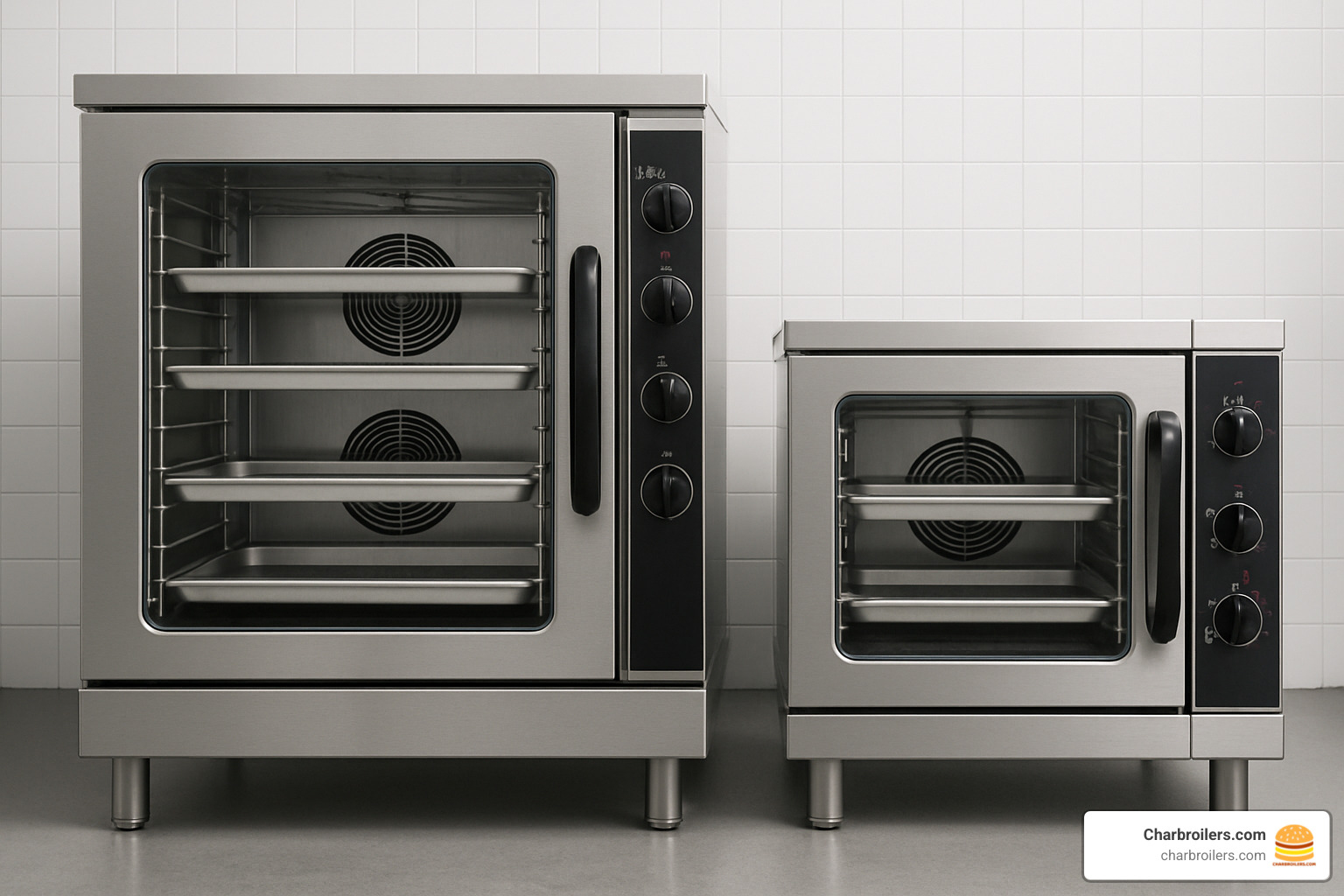
Quick Reference Guide to Used Commercial Convection Ovens
| Model Type | Capacity (Sheet Pans) | Footprint (WxDxH) | Power Type | Typical Use Case |
|---|---|---|---|---|
| Countertop | 3-4 quarter-size | 24" x 22" x 16" | 120V Electric | Cafés, food trucks |
| Half-Size | 4-5 half-size | 30" x 27" x 24" | 120/208V Electric | Bakeries, bistros |
| Full-Size | 5-20 full-size | 38" x 37" x 56" | Gas / 208/240V Elec | Restaurants, institutions |
| Double-Deck | 10-40 full-size | 38" x 37" x 70"+ | Gas / 208/240V Elec | Large kitchens, bakeries |
Note: Always verify your available amps, voltage, and gas hookups before buying!
Energy Efficiency & Certifications
Here's where used commercial convection ovens can really shine—and save you money every month. ENERGY STAR certified gas models operate at a minimum of 49% cooking energy efficiency. That translates to real savings of up to $188 per year on your utility bills compared to older, less efficient units.
Electric models with ENERGY STAR certification hit 71-76% efficiency ratings. Even a half-size electric unit can save you around $94 annually. Similarly, an ENERGY STAR half-size electric stat shows impressive idle energy rates that keep your standby costs low.
The idle energy rate is something most operators overlook, but it matters. Modern ovens are much better at reducing standby losses when they're not actively cooking. Lower numbers mean less money flying out your exhaust vent.
Always look for NSF, CUL, or UL certification markings on any used unit you're considering. These aren't just alphabet soup—they're your assurance that the oven meets health and safety standards for commercial food service. No certification? Keep looking.
Financing, Pricing & ROI
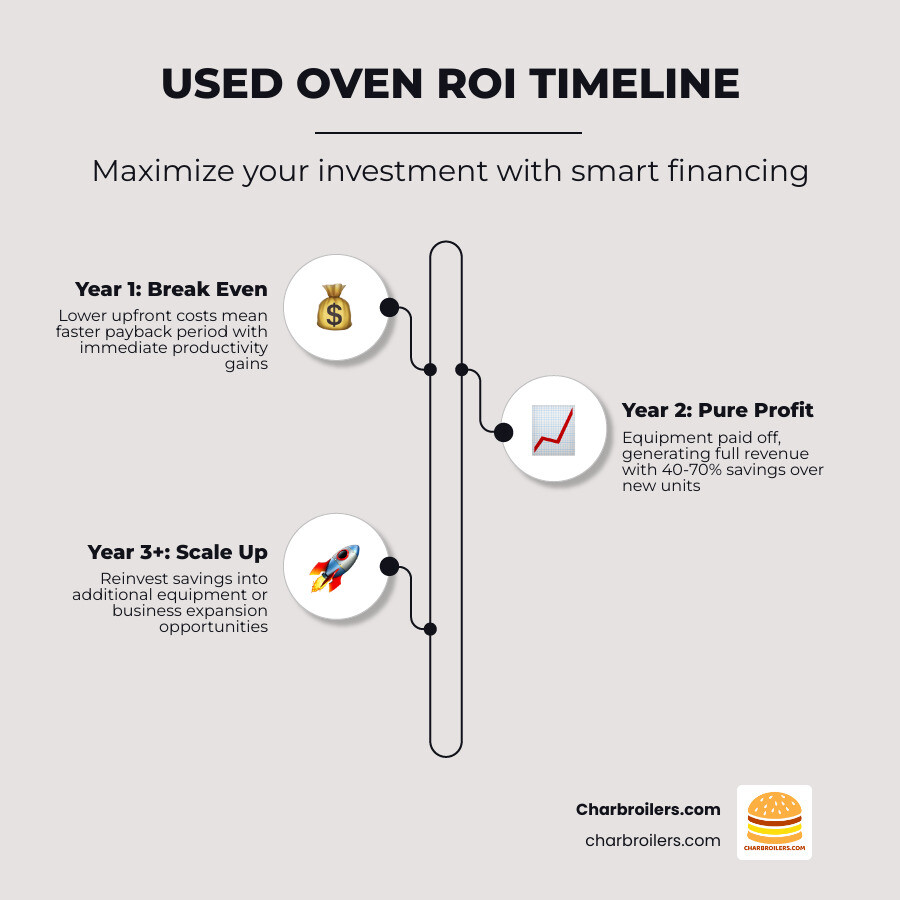
Let's talk numbers—because at the end of the day, your used commercial convection ovens need to make financial sense for your operation. The good news? The math works beautifully in your favor.
Most used commercial convection ovens fall into that $1,000–$4,000 sweet spot, though you can find smaller units starting around $175 or premium double-deck models reaching $5,000. Compare that to new ovens starting at $3,000 and climbing past $15,000, and you're looking at serious savings.
Here's where it gets interesting—you have choices beyond just writing a check. Auctions offer rock-bottom prices but come with limited warranties and zero return flexibility. Dealers typically charge a bit more but provide guarantees and prep the oven for immediate use. Think of it as paying a small premium for peace of mind.
Shipping costs are real, so budget accordingly. Depending on distance and size, expect $200 to $1,200 for crating, freight, and local delivery. A full-size oven heading across the country will cost more to ship than a countertop model going one state over.
Stretching Cash Flow with Rent–Try–Buy
Cash flow tight? Rent–Try–Buy programs let you test drive equipment without the full upfront commitment. You make weekly payments that preserve your working capital, and here's the kicker—60% of what you pay goes toward the purchase if you decide to buy.
Even better, those rental payments are 100% tax deductible as a business expense. So you're essentially getting a discount on your taxes while testing whether the oven fits your operation.
If your menu changes or you outgrow the unit, you can upgrade to a bigger model without losing your investment. It's like having an escape hatch built into your financing.
Negotiation Tactics When Buying Used Commercial Convection Ovens
Smart operators know that the listed price is just the starting point. Buying multiple pieces? Bundle them together and ask for a volume discount. Shopping during slow seasons—right after holidays or before summer—often reveals better deals as sellers clear inventory.
Found a minor flaw during inspection? Use it as leverage for a better price or ask the seller to handle repairs. Even requesting a short-term warranty (30-90 days) can provide valuable protection for your investment.
The key is being prepared to walk away. There are plenty of used commercial convection ovens on the market, so don't get emotionally attached to any single unit. Bake It Till You Make It: Local Used Commercial Convection Oven Deals
Maintenance & Safety for Long-Term Performance
A well-loved used commercial convection oven is like a trusty workhorse—it’ll keep your kitchen running smoothly for years, if you treat it right. Think of maintenance as your secret ingredient for long-term savings and stellar food quality.
Start with daily cleaning as a non-negotiable routine. Wipe down racks, clear out crumb trays, and keep the fan guard free of debris. For ovens with a steam feature, quarterly descaling is a must to prevent mineral buildup, which can affect performance and taste.
Don’t forget the moving parts: fan lubrication keeps things running quietly and efficiently, while regular checks for door alignment ensure you’re not losing precious heat (or overworking your oven). A poorly sealed door can mean uneven baking and higher energy bills—never fun for your bottom line.
Operator training is just as important as any cleaning product. Make sure everyone on your team knows how to use and care for your oven properly. It only takes one burnt batch or careless cleaning to turn a good oven into a costly repair job.
And while daily tasks go a long way, nothing beats an annual professional servicing. Scheduling a checkup with a qualified technician helps catch small issues before they turn into big headaches.
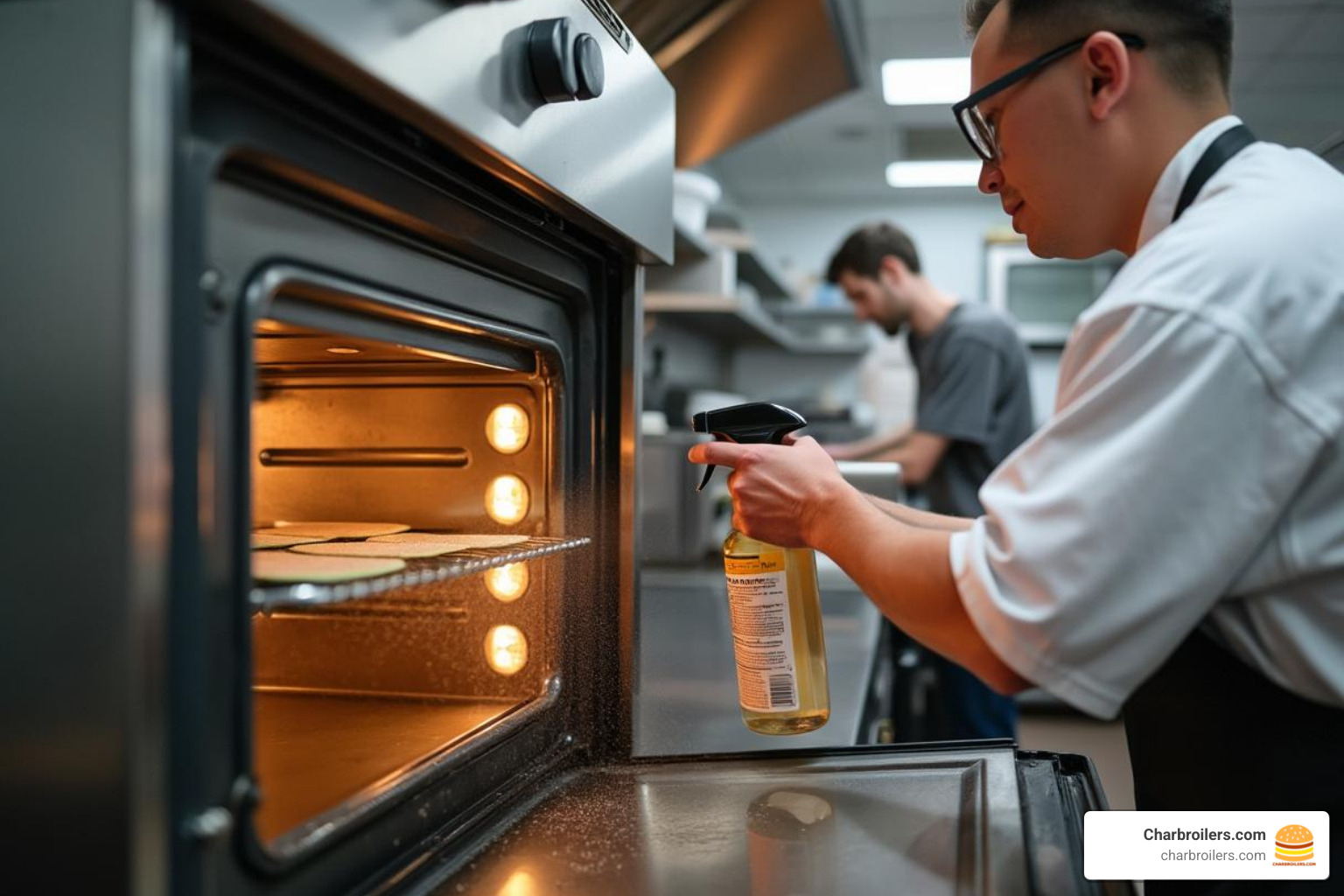
Cleaning Essentials
When it comes to cleaning your used commercial convection ovens, a gentle touch works best. Use non-abrasive pads to protect stainless steel surfaces and sensitive components. Rely on food-safe degreasers to cut through stubborn grease without leaving any chemical residue behind. And always remember to empty and clean the drip trays every day—letting grease pile up is a fire hazard and nobody’s idea of a good time.
If you want a deeper dive on cleaning tips, don’t miss The Ultimate Guide to Cleaning a Commercial Stainless Steel Griddle—the same principles apply to your oven, too!
Service Intervals & Warning Signs
Even the best-kept ovens need a little TLC. Keep an eye (and ear) out for uneven baking, slow heat-up times, or a noisy fan—these are often early warnings of issues like failing thermostats, tired elements, or bearings that need attention. If you notice thermostat drift (your oven isn’t holding temp like it should), it’s time for a test and possibly a repair. And don’t forget to regularly check your emergency shut-off—it’s better to find a safety issue before the health inspector does.
A little care each day, plus regular servicing, will keep your used commercial convection ovens humming along—and your kitchen team, customers, and accountant happy.
Frequently Asked Questions about Used Commercial Convection Ovens
Let's tackle the three questions we hear most often from restaurant owners shopping for used commercial convection ovens. These are the real concerns that keep operators up at night—and the answers that help them sleep better knowing they made the right choice.
How much should I expect to pay for a reliable unit?
Here's the honest truth: most reliable used commercial convection ovens will run you between $1,000 and $4,000. That sweet spot gets you a solid workhorse that'll handle your daily rush without breaking a sweat.
Now, if you're running a small café or food truck, you might snag a decent countertop unit for as little as $175. On the flip side, if you need a massive double-deck beast for a high-volume operation, you could be looking at $5,000 or more—but even that's still a fraction of what you'd pay new.
Don't forget the extras: shipping can add $200 to $1,200 depending on how far your oven needs to travel. Factor in any installation costs and accessories like extra sheet pans or racks. It's better to budget for these upfront than get surprised later.
Gas vs electric: which is best for my menu and utility setup?
This question always sparks debate in restaurant kitchens, and honestly, both have their place. Gas ovens are the speed demons—they heat up faster and cost less to run over time. If you're cranking out hundreds of pizzas or need that quick recovery between batches, gas is your friend. Just make sure you've got the gas hookup and proper ventilation in place.
Electric ovens are the steady, reliable option. They're easier to install (no gas lines needed), more portable if you ever move, and sometimes give you better temperature control for delicate baking. They're perfect for locations where gas isn't available or if you're going with a ventless setup.
Your menu matters too. High-volume roasting and baking? Gas wins. Precise pastry work or limited ventilation? Electric might be your better bet. And don't forget to check your local utility rates—sometimes electricity is surprisingly affordable in your area.
Do refurbished ovens still qualify for ENERGY STAR savings?
Absolutely! This is one of the best-kept secrets about buying used commercial convection ovens. As long as that ENERGY STAR sticker is still intact and the oven has been properly maintained, you'll get the same efficiency benefits as a new unit.
We're talking real money here—gas models with ENERGY STAR certification still deliver at least 49% cooking energy efficiency, which translates to around $188 in annual savings. Electric models can hit 71-76% efficiency, saving you roughly $94 per year on your utility bills.
The key is making sure the oven hasn't been modified or had its guts replaced with non-certified components. Ask the seller for proof of the ENERGY STAR rating, and look for that telltale sticker during your inspection. A well-maintained used oven can be just as efficient as the day it rolled off the factory floor.
Conclusion
Choosing used commercial convection ovens isn’t just a cost-saving move—it’s a smart, sustainable strategy that gives your kitchen a real edge. You get all the pro-level performance, quicker bake times, and lower utility bills you’d expect from top-tier equipment, but with far less strain on your budget. Plus, every oven that’s reused is one less chunk of steel in the landfill, so you’re helping the planet while boosting your bottom line.
At Charbroilers.com, we’re genuinely passionate about helping you make the best choices for your restaurant or food business. Whether you’re looking to upgrade your bakery, ramp up your pizza production, or get a new concept off the ground, we’re here to help you find, finance, and maintain the right oven for your needs. Our team knows the ins and outs of used commercial convection ovens, so you’ll get honest advice and solutions that actually work for your kitchen.
If you’re ready to upgrade, or just want to explore your options, we invite you to connect with us. We’re always happy to answer questions, talk shop, or guide you through the financing options that can make the numbers work.
For more insider tips on getting the most from your kitchen equipment budget, don’t miss our guide to commercial charbroilers for your restaurant.
Happy baking—and here’s to crispier crusts and better margins!
